Here’s a page with all the spider hoaxes and myths I could find. Please check these out before passing on emails that contain these!! If you find any others please send them in for me to include and check. Also make sure to check out our post about spider superstitions to find out if spiders are a sign of good luck.
Table of Contents
SPIDER MYTHS
Here are some of those myths and the facts behind them to help you know a bit more about spiders.
Myth: You are never more than three feet from a spider
Fact: We actually know the history of this spider myth. A 1995 popular article by famous arachnologist Norman Platnick begins, “Wherever you sit as you read these lines, a spider is probably no more than a few yards away.” I’d call that debatable even as is, but of course none of the many who repeated it got it right. The Honolulu Star-Bulletin, reviewing a local exhibit in September 1996, wrote “Scientists estimate we’re never more than three feet from a spider. That’s because some are microscopic, and actually live RIGHT ON YOU.”
The capitals are theirs, not mine, and they’re mistaking dust mites for spiders here. Then the nature writers got into the act. From a 1999 Sierra Club book on spiders: “Wherever you are, there is a spider within a meter of you.” From a 2001 book on nature in the city: “Even in Manhattan, you are never more than three feet from a spider.” And Norm Platnick (under pressure, I admit) misquoted his own earlier statement in a May 2002 CNN interview: “You’re probably within seven or eight feet of a spider, no matter where you are.” How close the nearest spider may be does, in fact, depend on where you are. If you’re standing on a lush green lawn, you can expect small spiders directly under your shoes, and others within 3 centimeters on all sides.
If you’re in the middle of a parking lot, the nearest spider could be 30, 50 or even 100 meters away. If you’re an airplane passenger, the only nearby spiders might be airborne ballooners, and spiders don’t balloon at night, so on a night flight you could be several kilometers from the nearest one. Most human situations will be somewhere between these extremes. So, is three feet (or 7-8 feet, or “a few yards”) your average distance from a spider? Nobody knows, because nobody’s done the intricate calculations to find the average distance between a human and a spider. Besides, the mythical statements in these books and articles don’t even call it an average. They’re just a case of how one man’s unguarded statement becomes apocryphal “common knowledge.”
Source: “Burke Museum: The Spider Myths Site“
Myth: All spiders are poisonous and will create harmful and potentially dangerous wounds.
Fact: While just about all spiders do have venom to consume their prey, it is unusual for a spider’s venom to affect humans in a detrimental way. Spider bites will often feel like a general insect bite with swelling, itching, and redness. Widow spiders, funnel web spiders, hobos and brown recluse spiders are ones you should be wary of, but bad bites are rare in most cases. Funnel web spiders have known to be fatal but like other spiders there is antivenene available to treat a bite. (The Uloborids (Arenea: Uloboridae) have no venom glads at all.)
Myth: We swallow spiders in our sleep.
Fact: This myth varies in numbers, from 4 a year to 20 in a lifetime, but there is no basis of fact or proof to this myth. Many unlikely circumstances would have to align in order for a spider to enter your mouth (and you to not wake up), and for you to swallow it. Your mouth is not a habitable place for a spider, and spiders generally avoid humans.
Myth: Spiders can enter your home through sink and shower drains, so this is why you often see spiders in bathrooms.
Fact: Modern plumbing doesn’t allow this to be possible, and drainpipes are generally unfriendly environments for spiders, offering minimal food. House spiders need a lot of water, so they often travel into bathrooms to drink out of residual water in drains. (The baths are slippery so they can’t get back out once they get in usually)
Myth: Tarantulas are extremely dangerous to humans.
Fact: Since tarantulas are so large, they are pretty scary creatures. They are often cast as the deadly monster in the movies and so many of us would be terrified if a tarantula made its way into our homes or worse. However, despite their large size, most tarantulas’ venom has very low toxicity to humans. In some cases, the bites might be a bit more painful because of the larger jaws, but the bites will usually affect you in the same way as a smaller spider.
Myth: Spiders have been known to lay eggs in the wounds they make in people’s skin.
Fact: Many people have heard a version of this story. A lady gets bitten by a spider and weeks later, a pimple like protrusion bursts and baby spiders come running out. As gross as this is, it is completely untrue. Your skin is not a suitable home for spider eggs, and spider biology does not work that way. Spiders usually create sacs to lay their eggs and keep the sac close by.
Myth: Spiders are often in our beds; that is why we always will wake up with spider bites on our skin.
Fact: Many of us have woken up with a mysterious big, red welt that resembles a bug bite. The mystery bite is often blamed on a spider. However, it is extremely rare for spiders to be in your bed. Unless your bed is on the floor in a basement or crawl space, spiders don’t see your bed as a potential hot spot for food. Spiders have no reason to bite humans unless they are very closely handled and pressed against the skin. Bumps and bites you wake up with are most likely from non-biting skin conditions or other insects (don’t rule out lice, mites, and bedbugs if you’re seeing bites frequently).
Spider Hoaxes
SOUTH AFRICA’S VIOLIN SPIDER (BROWN RECLUSE)
Claim: If you slept with water in the kettle don’t use it the next day. Please, ensure you re-rinse your kettle before using it in the morning. A family of 6 was found dead and a research was made that a deadly spider was found inside the kettle of which they drank tea from. Please, help and broadcast to all your contacts. This is serious guys, life can be taken by something so small
Accompanying Text: Warn as many people as you can. Due to the good rain and hot climate the Violin Spider is moving into houses. Please take note of this spider – it is very dangerous. Please warn kids & send to every one you know to alert them as well! This spider is breading at a rate of speed and is found in more and more South-African houses!!!!
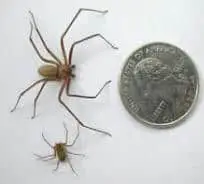
The Truth:
Spider venom cannot be ingested, it has to be injected into the blood stream to have any effect!! You could eat a spider with little effect on you. Also boiling water would kill any spiders so that would render them unable to bite as well!! Brown recluse or violin spiders as they are known in South Africa are not known to be fatal if even if they did bite you!!
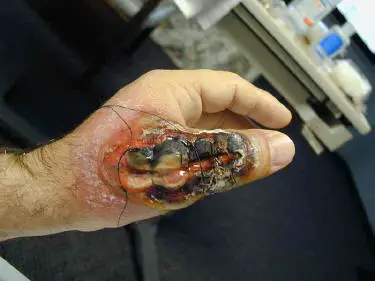
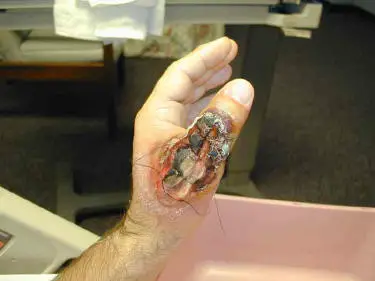
BROWN RECLUSE IN AUSTRALIA EMAIL
Claim:
Email also warns about the danger of Brown Recluse spiders and includes graphic pictures of a wound supposedly caused by a recluse bite . Text has changed slightly from earlier email.
Accompanying Text:
Please ensure all the family takes a good look at this spider……….maybe some should not look at the photos of the person who got bitten on the thumb and the end result…….but please take note of what the spider looks like. So if it looks like a huntsman and you are not sure………unfortunately, but for your safety’s sake……..KILL IT!!
The Truth:
The spider shown in this version of the warning message is indeed a Brown Recluse. Although the spider is known to inhabit a restricted area of a southern Australian state, there are no credible reports that suggest that the Brown Recluse or any similar spider is now spreading in Australia. Nor have there been any recorded bites from the spider in Australia. The message uses the same set of images that were included in an earlier email about Brown Recluse spider bites showing alleged horrific wounds caused. Some prankster has simply modified the original version to suit Australian conditions and sent it on its way. The Queensland Museum has also dismissed the warning message as a hoax.
Information: hoaxslayer.com
BROWN RECLUSE IN AUSTRALIA EMAIL (2)
Claim:
Email forward warns about the danger of Brown Recluse spiders and includes graphic pictures of a wound supposedly caused by a recluse bite.
Accompanying Text: – “Spider Bite – This is a new known spider, so please take note. Has been found all over Eastern Aust and heading to WA. Looks similar to a huntsman. This spider is in all states so watchout in fact it looks a bit like a huntsman Not a good look! Please take note of this spider – it is very dangerous. Please warn kids and send to every one you know to alert them as well! This spider is breeding at a rate of speed and is found in more and more houses!!!! ” – FALSE!
The Truth:
Same email as the one above only with a bit different text and no Red Cross warning.
BROWN RECLUSE SPIDER BITE PHOTOS
Claim: Email forward warns about the danger of Brown Recluse spiders and includes graphic pictures of a wound supposedly caused by a recluse bite. (See photos above).
Accompanying Text: “I thought that you would all benefit from these pictures, now the last couple pictures are nasty and the very last picture is the spider itself, but basically these pictures are showing the effects of a brown recluse spider bite. The following illustrates the progression of a brown recluse spider bite. The affected skin actually dies on his body. Some of the pictures towards the end are pretty nasty, but take a look at the last one — it is a picture of the spider itself. The Brown Recluse Spider is the most dangerous spider that we have here in the USA. A person can die from it’s bite. We all should know what the spider looks like. Send this around to people you love, because it is almost summertime. People will be digging around, doing yard work, spring cleaning, and sometimes in their attics. Please be careful.
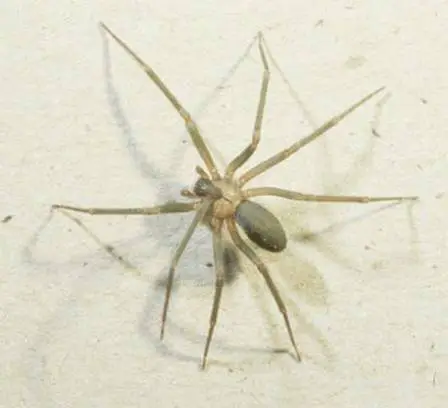
Spider bites are dangerous and can have permanent and highly negative consequences. They like the darkness and tend to live in storage sheds or attics or other areas that might not be frequented by people or light. If you have a need to be in your attic, go up there and turn on a light and leave it on for about 30 minutes before you go in to do your work.”
The Truth:
These were photos are often contained in an email warning about the brown recluse spider. Whether these photographs actually depict the effects of a brown recluse spider bite is difficult to determine. The accompanying text provides no useful identifying information, such as where the putative victim lives or where he was bitten, whether he obtained a diagnosis of his wound from a doctor, whether he sought medical treatment, etc. Various accounts place these pictures as having originated in Missouri, Wisconsin or California. Even if these photographs are genuine, they likely create an exaggerated sense of the danger posed by brown recluse spiders. As Phillip Anderson, a Missouri physician who specializes in brown recluse spider bites, explained in an article for the medical journal Missouri Medicine, ‘Almost all brown recluse spider bites heal nicely in two to three months without medical treatment at all.
Also the long-term medical outcome is excellent without treatment.’ Furthermore, says Anderson, ‘We are not aware of any verifiable deaths caused by the bite of the North American brown recluse spider.’ (He noted that several deaths from such wounds ‘had been reported in medical journals, but none of the reports is convincing.’) He also reported that out of ‘about 1,000 credible recluse spider bites,’ he was only aware of ‘about a dozen cases of impressive, sustained hemolysis.’Brown Recluse venom can cause necrosis (tissue death) in the area of the bite and can result in a deep and painful wound that takes a long time to heal. However, a number of other causes can result in similar wounds. I would suggest you think twice before forwarding this message. The wound depicted may not even be from a Brown Recluse and, in any case, the message overstates the risk of these spiders. Certainly, Brown Recluse spiders can be dangerous and people should be aware of what they look like and where they live. However, I would suggest reviewing other information about recluse spiders before you hit the forward button.
BLUSH SPIDERS
Claim:
Email prank warns of deadly ‘blush spiders’ from South America migrating to the U.S. in airliner bathrooms and lurking under toilet seats everywhere.
Accompanying Text:
FW: Warning! Spider in the toilet!
Importance: High
I’m told this isn’t a joke. Take it or leave it!: Please pass this on to everyone on your email list:
According to an article by Dr. Beverly Clark, in the Journal of the United Medical Association (JUMA), the mystery behind a recent spate of deaths has been solved. If you haven’t already heard about it in the news, here is what happened. 3 women in Chicago, turned up at hospitals over a 5 day period, all with the same symptoms. Fever, chills, and vomiting, followed by muscular collapse, paralysis, and finally, death. There were no outward signs of trauma. Autopsy results showed toxicity in the blood. These women did not know each other, and seemed to have nothing in common. It was discovered, however, that they had all visited the same restaurant (Big Chappies, at Blare Airport), within days of their deaths.
The health department descended on the restaurant, shutting it down. The food, water, and air conditioning were all inspected and tested, to no avail. The big break came when a waitress at the restaurant was rushed to the hospital with similar symptoms. She told doctors that she had been on vacation, and had only went to the restaurant to pick up her check. She did not eat or drink while she was there, but had used the restroom. That is when one toxicologist, remembering an article he had read, drove out to the restaurant, went into the restroom, and lifted the toilet seat. Under the seat, out of normal view, was small spider. The spider was captured and brought back to the lab, where it was determined to be the South American Blush Spider (arachnius gluteus), so named because of its reddened flesh color. This spider’s venom is extremely toxic, but can take several days to take effect.
They live in cold, dark, damp, climates, and toilet rims provide just the right atmosphere. Several days later a lawyer from Los Angeles showed up at a hospital emergency room. Before his death, he told the doctor, that he had been away on business, had taken a flight from New York, changing planes in Chicago, before returning home. He did not visit Big Chappies while there. He did, as did all of the other victims, have what was determined to be a puncture wound, on his right buttock. If the lawyer had visited Big Chappies there may have been the potential for a case against the restaurant. It would seem obvious to any legal action was warranted, but the restaurant was clearly not responsible for the cause of his death. Investigators discovered that the flight he was on had originated in South America. The Civilian Aeronautics Board (CAB) ordered an immediate inspection of the toilets of all flights from South America, and discovered the Blush spider’s nests on 4 different planes! It is now believed that these spiders can be anywhere in the country. So please, before you use a public toilet, lift the seat to check for spiders. It can save your life! And please pass this on to everyone you care about. – FALSE!
The Truth:
This is definitely not true. It gives itself away in the very first sentence: “According to an article by Dr. Beverly Clark, in the Journal of the United Medical Association (JUMA)…” There is no such journal. There is no “United Medical Association.” There is no record of “Dr. Beverly Clark” ever having an article published in any legitimate scientific publication. There have been no recent news reports of spider-caused deaths among air travellers in Chicago. There is no “Blare Airport” in Chicago (try O’Hare International Airport); and no restaurant in Chicago or anywhere else called “Big Chappies.” Lastly, there is no real genus of spider known as Arachnius gluteus (the gluteal muscles make up a large portion of the buttocks and “archnius” refers to spiders). There is such a thing as a “blush spider”, but it refers to patches of tiny varicose veins on the surface of one’s skin. If you’re attacked by one of these, call a plastic surgeon rather than the exterminator… unless, that is, you’re eager to be the butt of this Internet joke.
There is also a spider in Australia called the redback spider (a relative of the black widow) which was notorious in fact and folk lore for living in outback toilets and which has in fact bitten people on the “butt” as well as other places due to their habit of living under toilet seats and in these toilets. However outside toilets are rare in Australia these days and very few bites are recorded.
Information: About.com – Urban legends.
TWO STRIPED TELAMONIA
Claim:
Recycled email prank warning of the dangers of the Two-Striped Telamonia, purportedly a poisonous spider that hides under toilet seats and has killed five people in North Florida
Accompanying Text:
FW: a spider bite (please read) this could save ur life And you thought the brown recluse was bad!!! Three women in North Florida turned up at hospitals over a 5-day period, all with the same symptoms. Fever, chills, and vomiting, followed by muscular collapse, paralysis, and finally, death. There were no outward signs of trauma. Autopsy results showed toxicity in the blood. These women did not know each other, and seemed to have nothing in common. It was discovered, however, that they had all visited the same Restaurant (Olive Garden) within days of their deaths. The health department descended on the restaurant, shutting it down. The food, water, and air conditioning were all inspected and tested, to no avail. The big break came when a waitress at the restaurant was rushed to the hospital with similar symptoms… She told doctors that she had been on vacation, and had only went to the restaurant to pick up her check. She did not eat or drink while she was there, but had used the restroom. That is when one toxicologist, remembering an article he had read, drove out to the restaurant, went into the restroom, and lifted the toilet seat. Under the seat, out of normal view, was a small spider.
The spider was captured and brought back to the lab, where it was determined to be the Two-Striped Telamonia (Telamonia dimidiata), so named because of its reddened flesh color. This spider’s venom is extremely toxic, but can take several days to take effect. They live in cold, dark, damp climates, and toilet rims provide just the right atmosphere… Several days later a lawyer from Jacksonville showed up at a hospital emergency room. Before his death, he told the doctor, that he had been away on business, had taken a flight from Indonesia, changing planes in Singapore, before returning home. He did not visit (Olive Garden), while there. He did, as did all of the other victims, have what was determined to be a puncture wound, on his right buttock. Investigators discovered that the flight he was on had originated in India.
The Civilian Aeronautics Board (CAB) ordered an immediate inspection of the toilets of all flights from India, and discovered the Two-Striped Telamonia (Telamonia dimidiata) spider’s nests on 4 different planes! It is now believed that these spiders can be anywhere in the country. So please, before you use a public toilet, lift the seat to check for spiders. It can save your life! And please pass this on to everyone you care about. – FALSE!
The Truth:
This is the later version of the 1999 blush spider hoax email but boasts a few more official sounds details. There is a spider called a Two-Striped Telamonia but it’s a jumping spider found in various Asian rain forests and is definitely NOT harmful or on airplanes around the world!! In 2002 , the spider became the subject of an email hoax claiming that it was a fatal spider found lurking under toilet seats in North Florida. This hoax was a rehashing of an older email circulated in 1999 with similar claims, except under the name “South American Blush Spider (arachnius gluteus[sic])” – literally “butt spider”. It has also been found that similar email hoaxes (details of original changed here and there) has been found in other parts of the world claiming that the same thing happened in that country. No such events ever occurred!!
Information: About.com – Urban legends.
EXPLODING CACTUS SPIDER HOAX
Claim:
Email warns that certain kinds of cacti can harbour large tarantula spiders that will be explosively released from the plants when they reach maturity – FALSE
Accompanying Text:
“A true story and its source was the Australian Quarantine Inspection Service in Adelaide. A bloke and his family were on holidays in the United States and went to Mexico for a week. An avid cactus fan, the man bought a one-metre high, rare and expensive cactus there. On arrival back home Australian Customs said it must be quarantined for 3 months.He finally got his cactus home. Planted it in his backyard, and over time it grew to about 2 metres.
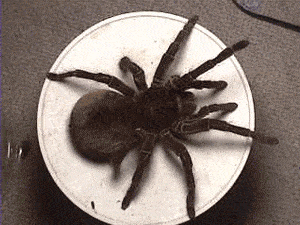
One evening while watering his garden after a warm spring day, he gave the cactus a light spray. He was amazed to see the plant shiver all over, he gave it another spray and it shivered again. He was puzzled so he rang the council who put him on to the state gardens people. After a few transfers he got the state’s foremost cactus expert who asked him many questions. How Tall is it? Has it flowered? etc. Finally he asked the most disturbing question. “Is your family in the house?” The bloke answered yes. The cactus expert said get out of the house NOW, get on to the front nature strip and wait for me, I will be there in 20 minutes. Fifteen minutes later, 2 fire trucks, 2 police cars and an ambulance came screaming around the corner.
A fireman got out and asked “Are you the bloke with the cactus?” I am, he said. A guy jumped out of the fire truck wearing what looked like a space suit, a breathing cylinder and mask attached to what looked like a scuba backpack with a large hose attached. He headed for the backyard and turned a flame-thrower on the cactus spraying it up and down. After a few minutes the flame-thrower man stopped, the cactus stood smoking and spitting, half the fence was burnt and parts of the gardens were well and truly scorched. Just then the cactus expert appeared and laid a calming hand on the bloke’s shoulder. “What the hell’s going on?” he says. “Let me show you” says the cactus man. He went over to the cactus and picked away a crusty bit, the cactus was almost entirely hollow and filled with tiger striped bird-eating tarantula spiders, each about the size of two hand spans.
The story was that this type of spider lays eggs in this type of cactus and they hatch and live in it as they grow to full size. When full size they release themselves. The cactus just explodes and about 150 dinner plate sized hairy spiders are flung from it, dispersing everywhere. They had been ready to pop. The aftermath was that the house and the adjoining houses had to be vacated and fumigated: police tape was put up outside the whole area and no one was allowed in for two weeks.And here’s what one of the spiders looks like sitting on a full size dinner plate.” – FALSE!
The Truth:
Spiders tend to be a common theme of hoaxes and urban legends. This one has morphed through a number of versions. In fact, the tale pre-dates the Internet, but email has given it new life. The example reproduced below boasts an Australian setting, but others have been set in a variety of locations around the world. In some versions, the cactus is a small potted specimen that is kept inside the house and does actually explode its load of spiders into the dwelling.It hardly needs to be said that the tale is completely untrue. Most types of tarantula live in underground burrows while a few live in trees.
However, there is no record of them building nests inside cactus plants. Furthermore, even if spider eggs were laid inside a plant, it certainly would not explode when the eggs hatched nor would they emerge fully grown!! Tarantulas are the giants of the spider world. Given their size and frightening appearance, it is not surprising that they play a starring role in this lovely old tale as well as numerous horror stories and Hollywood films. They are often portrayed as being extremely venomous. However, Tarantula venom is not considered to be of medical importance to humans. Of the hundreds of reported cases of tarantula bites very few cause anything more serious than temporary local inflammation. Information:: hoaxslayer.com
CAMEL SPIDER IN IRAQ
Claim:
Photo shows Camel Spiders in Iraq – TRUE
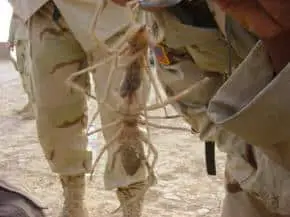
Accompanying Text:
“From someone stationed in Baghdad. He was recently bitten by a camel spider which was hiding in his sleeping bag. I thought you’d like to see what a camel spider looks like. It’ll give you a better idea of what our troops are dealing with. Enclosed is a picture of his friend holding up two spiders. Warning: not for the squeamish!
This picture is a perfect example of why you don’t want to go to the desert. These are 2 of the biggest I’ve ever seen. With a vertical leap that would make a pro basketball player weep with envy (they have to be able to jump up on to a camels stomach after all), they latch on and inject you with a local anesthesia so you can’t feel it feeding on you. They eat flesh, not just suck out your juices like a normal spider. I’m gonna be having nightmares after seeing this photo!” – FALSE!
The Truth:
The photo displayed above does indeed show camel spiders encountered in Iraq, but a number of the claims about them multi-legged creatures made in accompanying text are inaccurate or exaggerated. Claims of camel spiders being flesh-eating anesthesia-injecting beasts are folklore, not reality, so don’t worry that those serving in our country’s armed forces in Iraq are having to deal with man-eating creepy-crawlies the size of small cats. Although the creatures shown in the photograph above appear to be far too big for camel spiders, they look misleadingly large because of their closeness to the camera, which creates an illusion of exaggerated size. (Note their size in comparison to the uniform sleeve which appears in upper right-hand portion of the picture.)
Camel spiders, also known as wind spiders, wind scorpions, and sun scorpions, are a type of arthropod found in the deserts of the Middle East as well in dry areas of the United States. They’re technically not spiders but solifugae (although, like spiders, they belong to the class Arachnida). Camel spiders are the subject of a variety of legendary claims, many of them familiar to Americans because they were spread by U.S. servicemen who served in the Persian Gulf War in 1991, and re-spread at the beginning of the Iraq War in 2003
- Camel spiders can grow to be as large as dinner plates.
- Camel spiders can traverse desert sand at speeds up to 25 MPH, making screaming noises as they run.
- Camel spiders can jump several feet in the air.
- Camel spiders eat the stomachs of camels and lay their eggs there, hence the name “camel spider.” (Legend includes the detail that camel spiders eat camel stomachs from either the outside in or the inside out. In the former case they supposedly jump up from the ground and grab onto camels’ bellies from underneath; in the latter case exactly how spiders allegedly as large as dinner plates get into camels’ stomachs intact remains unexplained.)
- Camel spiders are venomous, and their venom contains a powerful anesthetic that numbs their victims (thus allowing them to gnaw away at living, immobilized animals without being noticed). U.S. soldierss were said to have been attacked by camel spiders at night but remained completely unaware of their plight until they awakened in the morning to find chunks of their flesh missing.
Wind scorpions are so named because they seem to move “like the wind.” They are also called solfugids, after their order. Other names for wind scorpions include camel spiders, sun scorpions, and sun spiders, because some species are active during the day. Most species of wind scorpion are actually nocturnal, but they are often attracted to light. They prey mainly on insects and other invertebrates, although some of the larger species occasionally eat small vertebrates, such as young lizards. Their unusually large chelicerae, or jaws, point forward and are used to crush and shred the prey.
Wind scorpions are not venomous but they can bite humans and the wound may become infected. Wind scorpions range in length from 1 to 70 mm (0.25 to 2.75 in). The most common species in the United States are a few centimetres (up to 1.2 in) long. They inhabit the drier, warmer parts of the west (though one species can be found in Florida) and are harmless. Camel spiders in Iraq shun the sun and generally hide during the day, coming out at night to do their hunting.
Information: Snopes.com
